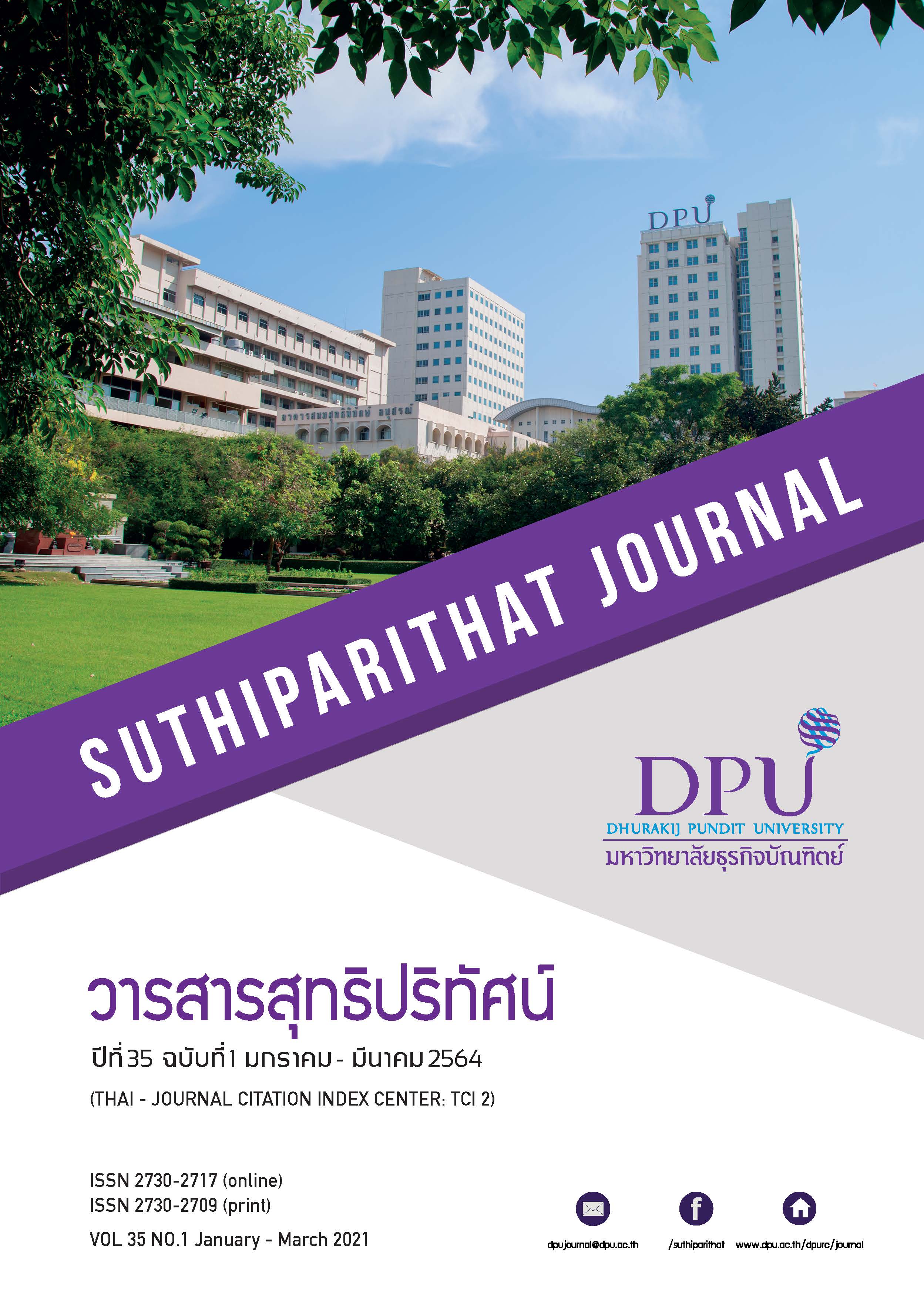THE EFFECTS OF ORGANIZING MATHEMATICS LEARNING ACTIVITES ON RATIO, PROPORTION AND PERCENTAGE BASED ON CONSTRUCTIVIST THEORY WITH COOPERATIVE LEARNING TECHNIQUE (TAI) FOR THE STUDENTS IN SEVENTH GRADE
Keywords:
Constructivist Theory, Cooperative Learning Technique (TAI), Ratio, Proportion and PercentageAbstract
The aims of this quasi-experimental research were 1) to study the effects of organizing mathematics learning activities for efficiency learning results according to E1/E2. 2) to compare the learning achievement before and after using the organizing mathematics learning activities and 3) to study the satisfaction of students towards organizing mathematics learning activities, on ratio, proportion and percentage based on Constructivist theory with cooperative learning technique TAI for the Students in Seventh Grade. The research samples were 33 Students in Seventh Grade in academic year 2019. The researchers used clustered random sampling in this research.
In addition, the research instruments were (1) organizing learning activities plan, which efficiency level was at 0.95. (2) Learning achievement test, which confidence interval level, difficulty level, and discrimination level was 0.899, 0.49-0.80 and 0.25-0.70 respectively. (3) the satisfaction of students towards organizing learning activities assessment form, which the reliability of Cronbach alpha coefficient was 1.00. The data analyzed by mean, percentage, standard deviation, t-test dependent
Lastly, the findings of the study were (1) the efficiency level of effects of organizing mathematics learning activities was at 85.60/86.36 which met the efficiency criteria according to E1/E2. (2) the learning achievement results after learning activities was higher than before organizing the activities, which statistical significance level was at .05. (3) the satisfaction level of students towards organizing Mathematics learning activities in general was 96.36 percent that means the student's satisfaction was at high to highest level.
References
กรมวิชาการ. (2551). หลักสูตรการศึกษาขั้นพื้นฐาน พุทธศักราช 2551. กรุงเทพฯ: องค์การรับส่งสินค้าและพัสดุภัณฑ์.
ชนาธิป พรกุล. (2544). การเรียนรู้แบบร่วมมือ: แคทส์ รูปแบบการจัดการเรียนการสอนที่เน้นนักเรียนเป็นศูนย์กลาง. กรุงเทพฯ: สำนักพิมพ์แห่งจุฬาลงกรณ์มหาวิทยาลัย.
ชูศรี วงษ์รัตนะ. (2550). เทคนิคการใช้สถิติเพื่อการวิจัย (พิมพ์ครั้งที่ 10). นนทบุรี: ไทยเนรมิตกิจ.
ทิพยา นิลดี. (2553). การเปรียบเทียบผลการเรียนรู้และความพึงพอใจในการเรียนคณิตศาสตร์ เรื่อง การบวกการลบ การคูณ การหารเศษส่วน ของนักเรียนชั้นประถมศึกษาปีที่ 5 ระหว่างกลุ่มที่ได้รับการจัดการ เรียนรู้แบบ 5E กับการจัดการเรียนรู้แบบร่วมมือกลุ่มเพื่อนช่วยเพื่อนรายบุคคล TAI (วิทยานิพนธ์ปริญญามหาบัณฑิต). พระนครศรีอยุธยา: มหาวิทยาลัยราชภัฏพระนครศรีอยุธยา.
ทิศนา แขมมณี. (2555). ศาสตร์การสอน องค์ความรู้เพื่อการจัดกระบวนการเรียนรู้ที่มีประสิทธิภาพ. กรุงเทพฯ: สำนักพิมพ์แห่งจุฬาลงกรณ์มหาวิทยาลัย.
ธนิต ตะเคียนเกลี้ยง. (2557). การพัฒนาผลสัมฤทธิ์ทางการเรียน เรื่อง การบวก การลบ การคูณทศนิยม สาระการเรียนรู้คณิตศาสตร์ ชั้นประถมศึกษาปีที่ 6 ด้วยชุดกิจกรรมการเรียนรู้แบบร่วมมือเทคนิค TAI (วิทยานิพนธ์ปริญญามหาบัณฑิต). ศรีสะเกษ: มหาวิทยาลัยราชภัฏศรีสะเกษ.
นิวัฒน์ สาระขันธ์. (2545). กิจกรรมเสริมความคิดเรียนคณิตให้สนุก. วารสารวิชาการ, 5(3), 45.
พจนา เบญจมาศ. (2558). การพัฒนาแบบฝึกทักษะวิชาคณิตศาสตร์ โดยการเรียนรู้แบบร่วมมือเทคนิค TAI กลุ่มสาระการเรียนรู้คณิตศาสตร์ สำหรับนักเรียนชั้นมัธยมศึกษาปีที่ 1 (วิทยานิพนธ์ปริญญามหาบัณฑิต). บุรีรัมย์: มหาวิทยาลัยราชภัฏบุรีรัมย์.
พิมพันธ์ เดชะคุปต์, และพเยาว์ ยินดีสุข. (2560). ทักษะ 7C ของครู 4.0. กรุงเทพฯ: โรงพิมพ์แห่งจุฬาลงกรณ์มหาวิทยาลัย.
สถาบันส่งเสริมการสอนวิทยาศาสตร์และเทคโนโลยี. (2560). คู่มือการใช้หลักสูตรกลุ่มสาระการเรียนรู้คณิตศาสตร์ ระดับชั้นมัธยมศึกษาตอนต้น (ฉบับปรับปรุง พ.ศ. 2560) ตามหลักสูตรแกนกลางการศึกษาขั้นพื้นฐาน พุทธศักราช 2551. สืบค้น 9 มิถุนายน 2562, จาก http://www.scimath.org/e-books/8380/8380.pdf.
สิริพร ทิพย์คง. (2545). หลักสูตรและการสอนคณิตศาสตร์. กรุงเทพฯ: สถาบันพัฒนาคุณภาพวิชาการ.
สุรกุล เจนอบรม. (2543). ทฤษฎีการสร้างสรรค์ด้วยปัญญาเพื่อพัฒนาการศึกษาตลอดชีวิต. วารสารครุศาสตร์จุฬาลงกรณ์มหาวิทยาลัย.
Biggs, J. B., & Moore, P. J. (1993). The process of learning (3rd ed.). Sydney, Australia: Prentice Hall.
Johnson, D. W., & Johnson R. T. (1987). Learning together and alone. Englewood Cliffs, N.J.: Prentice-Hall.
Downloads
Published
How to Cite
Issue
Section
License
Content and information of the article published at Suthiparithat Journal are based on the sole opinions and responsibility of author(s) only. Neither the editorial board involve in......






